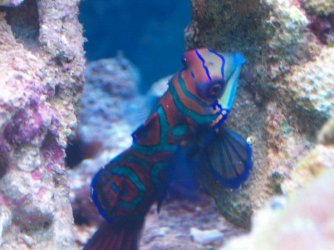Protein Skimmers (or To Skim or Not to Skim)
Hi..Should one add a protein skimmer to a nano reef? This topic is one of the most 'controversial' subjects for new nano-reefers. It makes sense tho' for us 'newbies' since the responses are always divided. So, I've tried to review some of the recent posts and summarize a bit: what
is consensus here to help some of us. The fine print...always do your own research...experience is the best teacher...and never trust everything you read:
What is a Protein Skimmer and Why Skim?
Our nano-systems are closed environmental systems..what we put in, does not easily come out. The addition of livestock, live rock and food adds nutrients and proteins that can accumulate and form dissolved organic acids (DSO's). As these accumulate, they can be a source of fodder for algae blooms, cyanobacteria and contribute to poor water condition which could also affect the well-being of corals.
A protein skimmer is a device that 'culls' these DSO's out of our systems. Without going into physics or the mechanical design of skimmers (that's for you to read up on), a skimmer is a chamber that creates a jet of bubbles. As the bubbles pass upward through this system, DSO's adhere to the bubble's surface and are released when the bubble bursts. These proteins are then collected at the surface in a cup for removal. A protein skimmer could also be included under the heading of a device for 'nutrient export'.
The Pro's of Skimming
Here are some of the consistent comments about advantages of skimming:
1) helps with overall water quality
2) replicates nature, waves crash and skim the oceans leaving skim on beaches
3) water changes are periodic and skimming is constant
4) gives a margin of error in terms of overfeeding
5) skimming the bad far outweighs whatever 'good things' are skimmed
6) one can't test for skimmable products likes metabolites, intermediates, toxins, etc and there are no good data out there as to what 'good nutrients' are skimmed off
The Con's of Skimming
Here are some of the consistent comments about going without a skimmer:
1) removes desirable nutrients
2) too large and make too much noise
3) require additional plumbing or don't fit well with certain systems
4) it's an unnecessary expense if you are consistent with water changes, light stocking and not overfeeding
5) creates microbubbles in the tank
6) possible oxidation of sensitive molecules (one poster listed iodine)
7) some ricordia/zoanthids prefer a small amount of DSO's
How Do I Decide if I Should Buy One?
Here are some thoughts to help you decide on whether or not to buy a protein skimmer:
1) What is my bioload....am I heavily stocked (not a good idea for a nano) or do I have heavy polluters?
2) Do I have a tendency toward overfeeding or do I have no other methods for nutrient export (no refugium or macroalgae)
3) Lack of dedicated time for tank maintenance and water changes (not a good habit for a nano but sometimes unavoidable for busy workers)
Can I Make My Own Skimmer?
Yes you can. There are many do-it-yourself (DIY) skimmer posts out there. Here are a few links:
http /www.nano-reef.com/forums/showthread...ght=DIY+Skimmer
http
/www.nano-reef.com/forums/showthread...ght=DIY+Skimmer
http /www.nano-reef.com/forums/showthread...ght=DIY+Skimmer
http
/www.nano-reef.com/forums/showthread...ght=DIY+Skimmer
http /www.nano-reef.com/forums/showthread...protein+skimmer
What Protein Skimmer Should I Buy?
Summary
/www.nano-reef.com/forums/showthread...protein+skimmer
What Protein Skimmer Should I Buy?
Summary
In summary, the choice of using a protein skimmer is all yours. There is still no definitive consensus, however, IMO, after being in the nano-reef group for a few months I think the advocates of protein skimming are in the majority (unless the water changers are just not posting). While posting this and prior to the poll results, Skilter and Visi-Jet skimmers appear to get the worst comments. Most popular skimmers are the AquaC Remora and CPR Bak-Pak. For us NC owners, there isn't a skimmer that fits into our tanks, so, options include:
--using an external skimmer either periodically so it doesn't destroy the beauty of your tank or plumbing it by drilling holes thru the hood in the back or
--waiting and checking in with Chris at nanocustoms.com. They are reportedly designing an internal protein skimmer to fit in the back in chamber 2.
SH


 /www.premiumaquatics.com/Merchant2/m...Code=Wavemaking
/www.premiumaquatics.com/Merchant2/m...Code=Wavemaking

 . Then she asked if she could have a dory. The guy said "how big is your tank" and the woman goes "ooh about this big" (makes motion about two foot by one foot with her hands). Luckily the fish shop worker said that marine tanks were expert only and very difficult. Let's hope that she goes home and does some research for it.
. Then she asked if she could have a dory. The guy said "how big is your tank" and the woman goes "ooh about this big" (makes motion about two foot by one foot with her hands). Luckily the fish shop worker said that marine tanks were expert only and very difficult. Let's hope that she goes home and does some research for it.

